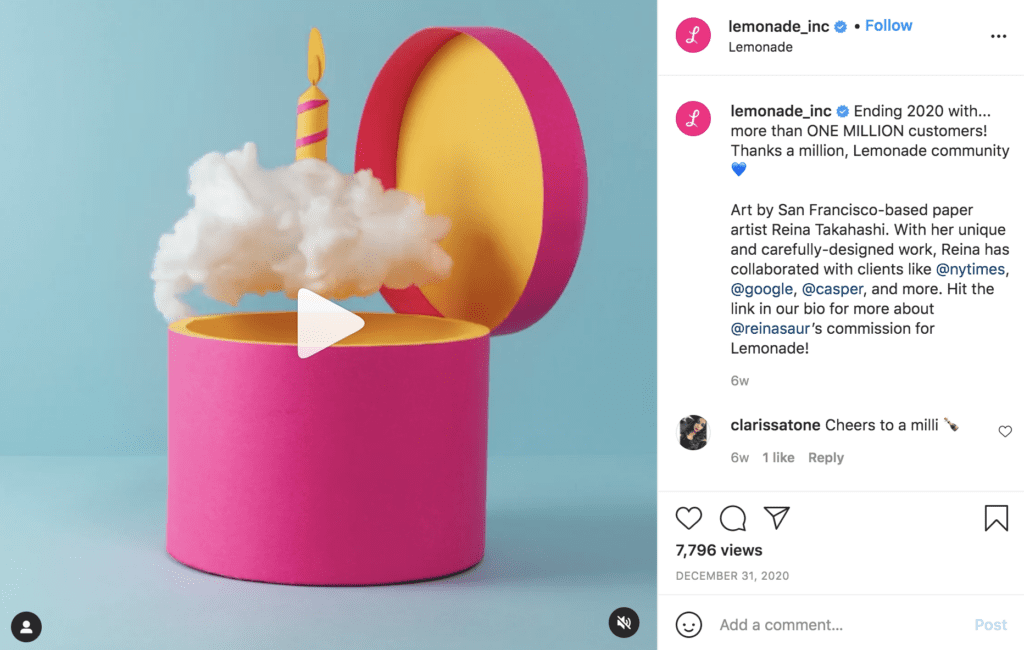
The insurance market is highly competitive, with big marketing budgets and highly recognizable mascots – like the Geico gecko and Progressive’s Flo.
The direct-to-consumer insurance company Lemonade (which went public in July) started four years ago in New York City offering renters’ insurance – the type of $60 per year policies the big guys didn’t want to bother with.
Lemonade’s strategy is to sign up customers for its inexpensive renters’ insurance policies, and keep them happy with customer service features like three-second, automated claims payouts. When those customers buy a home, adopt a pet or buy life insurance, they choose Lemonade.
Unfortunately, insurance is a boring topic – particularly to the young professionals it wants to attract.
“No one wants to follow an insurance company on Instagram,” said Nuno Ferreira, head of creative at Lemonade. “It takes a little bit of courage and self-assurance as a brand to acknowledge that.”
Lemonade tackled that challenge with an Instagram presence that’s design-oriented and fun. Pre-pandemic, it took everyday objects and dunked them in Lemonade’s signature pink paint. The coronavirus pandemic made it rethink its Instagram strategy.
So Lemonade has been showcasing the work of up-and-coming artists, the kind of freelancers that Ferreira thought would be heavily affected by the pandemic. Lemonade commissioned work from 30 artists since the summer, and amassed 17 million views on the social media platform in the process.
Lemonade doesn’t expect someone will sign up for an insurance policy after viewing the artwork. “There’s plenty of platforms for us to have marketing messages, and plenty of ways to reach consumers,” Ferreira said. Focusing on design and doing good by supporting artists offers a “different window into the brand.”
That’s not t o say social media can’t also drive acquisitions. One of Lemonade’s successful marketing campaigns used the stickers on Instagram Stories, asking people to guess if some of their glowing customer reviews were for Lemonade – or if they sounded like reviews of other products, like a delicious burrito.
o say social media can’t also drive acquisitions. One of Lemonade’s successful marketing campaigns used the stickers on Instagram Stories, asking people to guess if some of their glowing customer reviews were for Lemonade – or if they sounded like reviews of other products, like a delicious burrito.
When it comes to Lemonade’s home account, however, “a beautiful, intriguing Instagram feed was more important to us than a run-of-the-mill marketing feed,” Ferreira said.
Lemonade’s approach is working.
Four years in, it’s signed up 1 million customers, a pace that’s many years faster than the competition. And its thesis is holding true: young customers are already insuring more with Lemonade. The insurer launched pet insurance in the middle of 2020, in time for the pandemic puppy boom. Pet insurance already counts for 4% of its business, and many of the signups come from existing customers.
To acquire those customers, Lemonade spent $57.9 million on marketing in the first nine months of last year, according to its Q3 2020 investor filing, down slightly from the $64.9 million in spend during the year before. Those marketing spends are billions less than the leaders in the space like Geico and Progressive spend.
But Lemonade’s bet is that these big companies weren’t talking to these customers before. Most of its customers hadn’t bought insurance before, and 75% are under 35.
“It’s less of a demographic and more of an attitude: people who embrace tech and see how transformative it is,” Ferreira said.













